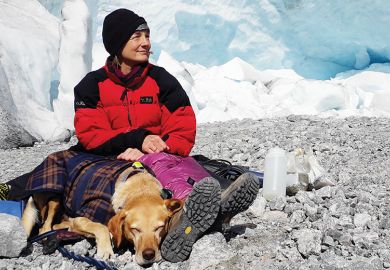The emergence of plate tectonic theory during the 1960s marked a revolution in the science of geology. While subduction - the process whereby the ocean crust is swallowed up by the mantle - is a consequence of plate tectonics, and thus a part of the whole process, it is nonetheless of fundamental importance, not least because igneous rocks formed by subduction led, by and large, to the development of the continental crust. And as the continents provide a stable platform above sea level on which all terrestrial life depends, the link between subduction magmatism and crustal formation takes on a Gaian perspective. On a less sentimental level, subduction zones are major sites of volcanism on earth, and the recycling, through the subduction process, of oceanic lithosphere back into the mantle is fundamental to both the chemical and thermal evolution of the planet.
Despite several decades of field, petrological, geochemical and geophysical investigations, subduction zones remain enigmatic. Any unified model of subduction zone magmatism must be able to identify the relative contributions of the potential magma source regions (subducting slab and overlying mantle wedge), along with the role played by island arc or continental crust in modifying, through contamination, primary melt compositions. Furthermore, these geochemical processes must be integrated with a consistent physical (thermal and dynamical) model that explains where melts are generated and how they are then transported through the lithosphere. This is a tall order. Not surprisingly, no self-consistent physicochemical model yet exists that explains subduction zone magmatism in a robust way.
Yoshiyuki Tatsumi and Steve Eggins bring together some of the latest thinking on how subduction zones act as global magma factories. The main bulk of the text focuses on answering four simple, yet fundamental derived questions. First, why does melting take place where cold lithospheric plates sink into and cool the mantle? Second, what is the origin and significance of the spatial distribution of subduction zone volcanoes? Third, why is the chemical composition of subduction zone magmas so distinct from magmas in other tectonic settings? Fourth, why does magma composition often display systematic change across volcanic arcs?
It is perhaps not surprising that many examples of subduction processes are from the northeast Japan arc and other regions of southeast Asia, given the location of both authors (Japan and Australia). They are much closer to the action than European (and many) North American geologists, to the "ring of fire", that is the line of active volcanoes and earthquake activity that marks the perimeter of the Pacific Ocean basin.
The text is well laid out, and supported adequately with figures and pages of references. Although relatively short, the book covers much ground, with topics on the geochemistry and physical characteristics of subduction zone magmas, hydrous mineral stability, across-arc chemical variation and the composition of subduction zone fluid phases.
The latter section is already in need of some revision as a result of recent experimental work on the dominant geochemical characteristics of subduction-related magmas: this shows that the enrichment of large-ion lithophile elements (Rb, Ce, Ba etc) over the high-field-strength elements (Ta, Nb, Zr etc) is due to the partitioning of lithophiles into chloride-rich aqueous fluids released from the subducting slab during dehydration.
However there are some obvious omissions, such as the important role of extension of the overriding continental plate in controlling the generation and spacing of arc volcanoes. The link between tectonics and magmatism is barely alluded to, and continental arc magmatism is given short shrift. Perhaps more important, plutonic rocks are completely ignored. This is a great shame as continental arc batholiths tend to record the magmatic history of subduction zones over much greater time scales than transient volcanic systems.
In this sense I found the book disappointing. Billed as the first in a new series, "Frontiers in Earth Sciences", it lacks the depth I hoped for. Most of its material can be found in any advanced igneous petrology textbook. While the final chapter on mantle-wedge dynamics, a topic often not covered in any detail in conventional, geochemically oriented texts, is welcome, it falls short of the mark. Where is a summary of the important relevant work on mantle porosity, permeability and U/Th disequilibria? What about a review of the mechanism behind lateral transport of water away from the dehydrating slab? Exactly how important is slab melting? Why emphasise mantle diapirism when fracture ascent is easily the most effective magma transport mechanism in the lithosphere?
Geophysical fluids, whether melts, magmas, or hydrothermal aqueous solutions, are the workhorses of planetary differentiation and evolution. Within the continental crust, natural fluids made up of water, salts and nonpolar gases play a vital role in catalysing metamorphic reactions, transporting heat and matter, and in concentrating precious metals into economically viable ore deposits.
K. I. Shmulovich, B. W. D. Yardley and G. G. Gonchar have brought together papers on these fluids from a realm as mysterious scientifically as the lower continental crust - the former Soviet Union. Having worked with Russian geologists and frequently struggled to understand concepts and processes that sound nothing less than bizarre to western ears, I approached this book with some trepidation. I remembered a research seminar at the Vinogradov Institute of Geochemistry, Irkutsk, on the origin of subduction-related granite magmas, during which it became apparent that not only was a large section of the audience of the opinion championed by the late D. S. Korzhinskii that most granite was never a magma in the first place, a good number did not believe in plate tectonics at all.
I need not have worried. Fluids in the Crust provides a valuable and comprehensive review of the detailed experimental work on crustal fluids and their interaction with rocks and minerals undertaken over the past decade in the former Soviet Union. Although chapters were originally in Russian, the editors have ensured that the English is clear and that the figures are of high quality.
Most of the experimental studies are concerned with the geochemical behaviour (complexing, solubilities and transport properties) at elevated temperatures and pressures of ore metals. Such a wealth of new experimental data is extremely useful and will expand significantly the database available in the west, not to mention providing some handy tips on experimental rig design.
I found the two chapters on the thermal decompaction of rocks and their permeability at elevated temperatures and pressures particularly interesting. To my knowledge, no similar experiments have been undertaken in the west.
Nick Petford is senior lecturer in igneous mechanics, Kingston University.
Fluids in the Crust
Author - K. I. Shmulovich, B. W. D. Yardley, and G. G. Gonchar
ISBN - 0 412 56320 7
Publisher - Chapman & Hall
Price - £69.00
Pages - 323
Register to continue
Why register?
- Registration is free and only takes a moment
- Once registered, you can read 3 articles a month
- Sign up for our newsletter
Subscribe
Or subscribe for unlimited access to:
- Unlimited access to news, views, insights & reviews
- Digital editions
- Digital access to THE’s university and college rankings analysis
Already registered or a current subscriber?



